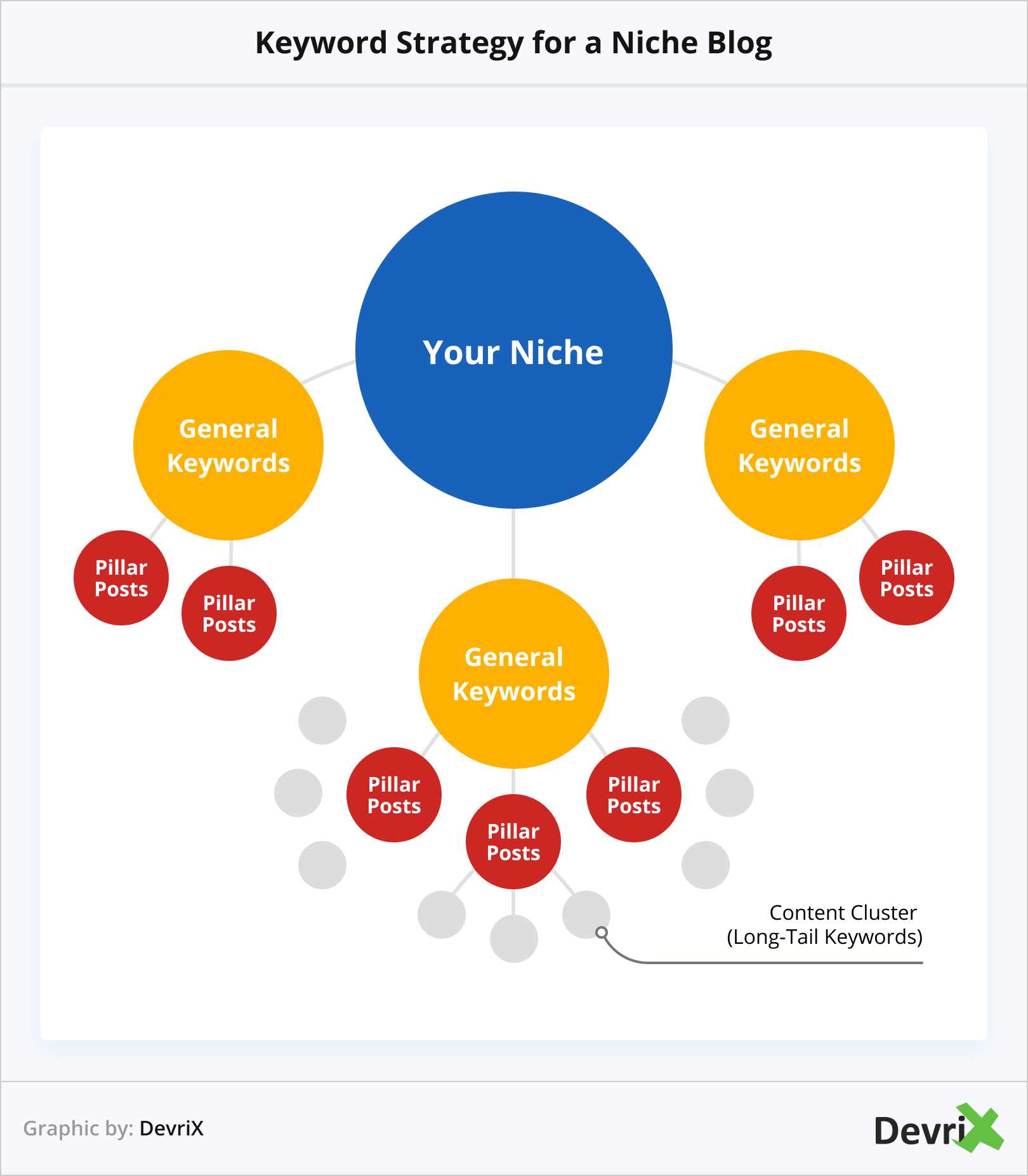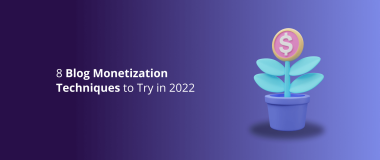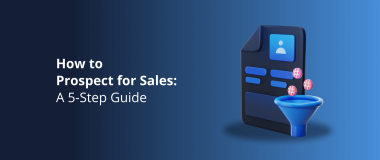Nowadays, niche blogs are all the rage in content marketing.
They are a powerful tool for large companies, small businesses, and stand-alone bloggers alike, and allow them to attract a specialized audience, build loyalty, and create engagement. Furthermore, they can be leveraged as a branding asset and help establish the publisher as a thought leader in their field.
But how to create a niche blog properly?
For your blog to deliver the desired results, you need to plan carefully and strategize every aspect of it – niche scope, keywords, audience engagement, SEO, promotion, monetization – everything.
As with any other endeavor, the first steps are the most difficult, but also the most important ones. The better you plan and implement them, the more likely it is that your niche blog becomes a success.
In this article, we provide a step-by-step guide on how to create a niche blog. Regardless of whether you are a one-man show or a whole team, following it will allow you to optimize your time and maximize the performance of your content right from the start.
Read on to learn more!

1. Choose a Niche for Your Blog
The first and most important step, of course, is to choose the right blog niche.
What direction you take with this depends entirely on your knowledge and expertise.
While, nowadays, with some online research you can gain a basic understanding of, practically, any topic, if you want your blog to be the go-to place for information in your niche, you’ll need a little bit more than that.
To be above the average, you have to provide value that nobody else can.
Simply put, you need your own twist on the information that’s already out there.
This means that when you are considering what part of your industry to focus on, you should choose not only a niche that you know well, but one where you have passion, unique experience, and one-of-a-kind insight.
For example, parenting is a great blogging niche, but it becomes even better when you make it your own – such as “parenting twins”, or “parenting in the wild”, or “reading with your kids”, or “lazy parenting for working moms”, or “parenting as a single father”, or “why being a father is not the same as babysitting”, or whatever else is unique to you.
Choosing a niche for a business blog is usually a bit easier. That’s because you need to focus on the unique value you can provide to your customers, the benefits of using products such as yours, the issues that may come from using these products, your customer’s pain points, and so forth.
However, again, the point is to find a unique perspective and/or develop branding that sets you apart.
2. Map Your Goals
Creating a niche blog shouldn’t be a goal in itself. In other words, to be successful, your blog needs to be a means to an end.
By setting up targets to achieve, you will be able to measure performance and ROI and take steps to improve them when necessary.
When mapping your goals, it’s important to clearly define what you want to achieve. This, of course, can depend on many factors, including but not limited to whether you are creating a business blog or a personal one, what type of monetization you are after, how large is your audience, the niche itself, etc.
However, some of the most common goals blog owners pursue are:
- Building an audience
- Generating organic traffic
- Lead generation
- Affiliate partnerships
- Growing your email list
- Establishing a personal or business brand
- Sharing experience
- Subscription revenue
- SERP branding
- Brand awareness
When just starting your niche blog, you can choose one of those, or focus on a few at a time. In any case, it’s good practice to consider and prepare different strategies to achieve your main goal.

3. Research Your Audience
If you are to attract an audience of devoted readers, you need to understand what your audience wants and deliver on it.
Depending on your budget and resources, you may not be able to afford to conduct market research. This is usually expensive, time-consuming, and difficult to implement.
However, this doesn’t mean that you can’t ask around, observe, and, why not, even distribute a survey.
Furthermore, you can research what your competitors are doing, and how their audience responds to it. Your goal, of course, should not be to steal ideas but to borrow good practices.
Some of the things to take into consideration when researching your audience are:
- Demographics
- Place of residence
- Relevant pain points
- Needs
- Financial status
- Social status
- Content consumption habits and preferences
- Device type preferences (mobile or desktop)
- Online spending habits
This information will help you define your brands, find the best way to approach your audience, build a connection to them, and, eventually, monetize your blogging efforts.
4. Create a Keyword Strategy

Before you start creating content for your blog, you need to decide on the topics that you’ll focus on.
Once you know what your niche is, and what your target audience cares about, you should perform keyword research.
- Start with choosing a number of general topics relevant to your niche and your field of expertise – these will be the main information hubs that your blog will revolve around.
- Research the keywords that people most often search when looking into these topics. Again, look for relatively general search terms.
- Then, you can research the most important subtopics related to them and list them as the center of potential pillar posts.
- Once you have the pillar topics, research their subtopics and list them as keywords for the potential content clusters.
- Depending on the keywords, each article of the cluster can be a mini pillar page with its own cluster.
Of course, it’s not necessary to find and list all the relevant keywords that you will write on – it’s probably even impossible. However, the more keyword groups you prepare and the better structured they are, the easier it will be to start creating content.
Also, by planning and optimizing your content carefully, you will be less likely to fall into the trap of keyword cannibalization in the future.
However, the main reason why you need a keyword strategy for a niche blog is SEO. When you cover all relevant aspects of your topics, organize your content properly, and build a strong information architecture and internal linking strategy, it will be much easier to convince search engines that you are an expert.
And, similar to clients, search engines favor experts and show their links more often in the SERPs.
5. Think of SEO
Search engine optimization is not just about the keywords. Sure, those are very important, but there is much more to care about.
Simply put, for your blogging efforts to be worth it, your website and content need to be discoverable and properly optimized for search engines.
Without this, your articles will reach only a limited audience of people who you already know and have on your email list, and you will fail to facilitate the key to all niche blogging benefits – organic traffic.
The most important aspects of SEO that you should consider are the following:
- Indexability by Google
- Website security
- Schema markup
- Metadata
- Sitemap
- Loading speed
- Content structure
Additional issues may be of concern when/if you accumulate large amounts of content, but the above-mentioned should get you started.
Furthermore, you should consider whether you will be able to take care of SEO yourself or hire professional help.
6. Set Up a Workflow

When you are a one-man show, creating a content workflow may seem overkill, but it’s still necessary if you are taking blogging seriously.
It helps you organize and streamline your efforts and ensures a smooth-running work process.
Still, you may decide to bypass this step, it’s up to you.
However, when you are running a business blog and there are multiple people involved, having a clear and robust workflow is a must.
Thanks to it, everyone involved will know the steps in the production process and will be aware of who is responsible for the phase before and after them. This will make communication much easier, and will also reduce bottlenecks.
Furthermore, a workflow includes the deadlines for each of the stages in the content development process, which helps people follow through with them.
All in all with a workflow in place, you can count on higher productivity and efficiency.
Depending on how many people are involved and their responsibilities, the workflow may vary, but, generally, it consists of the following steps:
- Title suggestion
- Keyword research
- Topic research and outlining
- Approval
- Writing
- Proofreading and edits
- Plagiarism check
- Subject matter expert review
- Graphic design
- SEO optimization
- Publishing
7. Build an Editorial Calendar
Having an editorial calendar is integral for the success of your niche blog.
To be able to satisfy the needs of your audience, retain them, and keep them engaged, you need to consistently provide relevant and interesting content.
This means not only picking up great topics but publishing regularly as well.
However, when you operate in a narrow niche, it’s easy to run out of ideas, experience writer’s block, or simply fail to meet your content production goals.
With an editorial calendar, you can plan your efforts, and build a consistent strategy including how often to publish, what days of the week to favor, what types of content to focus on, and what topics to publish depending on outside factors such as seasons, events, etc.
When you have a calendar – be it a simple spreadsheet or dedicated software – you can have a clear overview of the content creation process, the ready-to-publish articles, the pieces you need to write, and the topics you need to cover next.
Furthermore, you can create your content in advance, build a stockpile of articles, and make sure that there will not come a moment when you have nothing to publish.
8. Work on Your Personal Branding

Regardless of what niche you decide to pursue, it’s a safe bet that there are already tens if not hundreds of popular bloggers in it. To be able to stand out, you need to figure out your public persona and implement it in your personal branding.
If you are running a company blog, it should match the brand identity you display on other channels. This way, you will build upon your already existing personality and will ensure consistency and recognition.
To that end, research what others in your industry and niche are doing so you can set yourself apart – focus on what makes you unique.
But don’t stop with that. Consider what you have in common with your audience, what they like and dislike, what they need, and how they see themselves.
The goal is to make your blog branding a touchpoint between you and your target reader that will convince them to choose you over others that offer similar value.
9. Plan Promotion
As great as SEO is, the SERPs are not the only place where your content should become a hit.
Promoting your blog ensures that people learn about you and discover your content. Also, if they are following you on different channels, they are more likely not to miss any new articles.
Furthermore, when you have traffic from different sources, even if one channel fails to deliver engagement for one reason or another, the rest will be able to compensate.
However, the main purpose of promotion is to reach new audiences and grow your reach.
Here are some of the most popular techniques to consider:
- Social media posts
- Paid social media publications
- Email marketing
- Affiliate marketing
- Word-of-mouth marketing
- Influencer marketing
- Repurposing content for different channels
- Guest posts
10. Consider Monetization
Even if you’ve started a niche blog for the sole purpose of helping others and sharing your personal experience, this doesn’t mean that you shouldn’t at least consider the available monetization opportunities.
Nowadays, it’s easier than ever to monetize your blog. In fact, depending on how much effort you are willing to put into it, there are multiple ways to choose from.
Here are the most common ones:
- Display ads
- Affiliate links
- Subscriptions
- Sponsored content
- eBooks
- Coaching service
- Online courses
Bottom Line
Creating a successful niche blog requires planning, consistency, and dedication.
While you may be eager to start publishing and interacting with your audience, it’s always best to take your time with the preliminary work. This will minimize the chance of unexpected setbacks, and ensure that your progress is under control.
Depending on the niche, there may be other steps to consider aside from the list provided in this article. The best way to figure them out is to research the top competitors in your industry and observe them for a while.
This will give you additional insight into the specific niche and may help you come up with ideas for your own blog.
However, don’t put off that launch date too much, once you feel ready – just do it.
Oh, and if you need help with the tech stuff, we are one call away!




